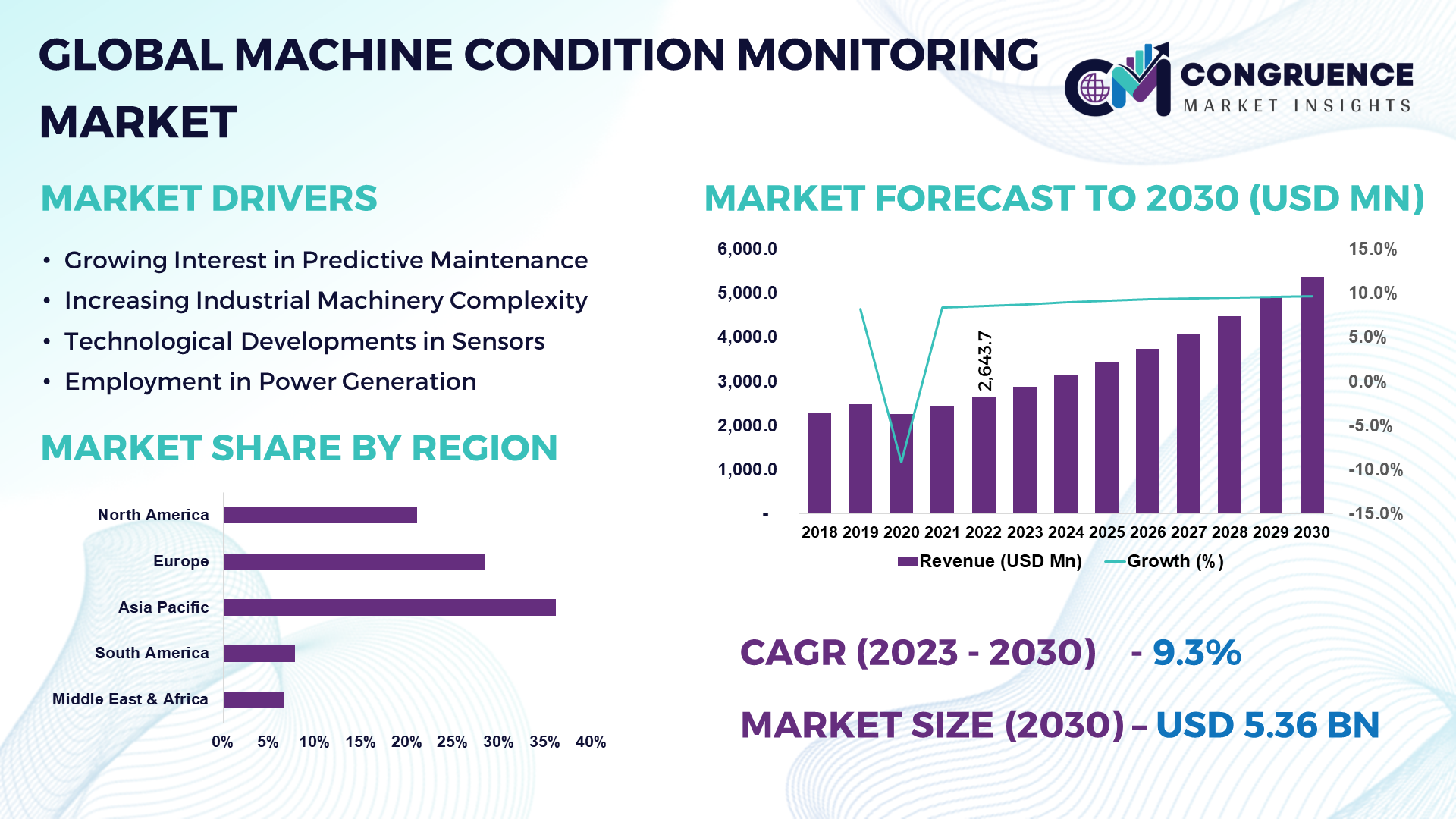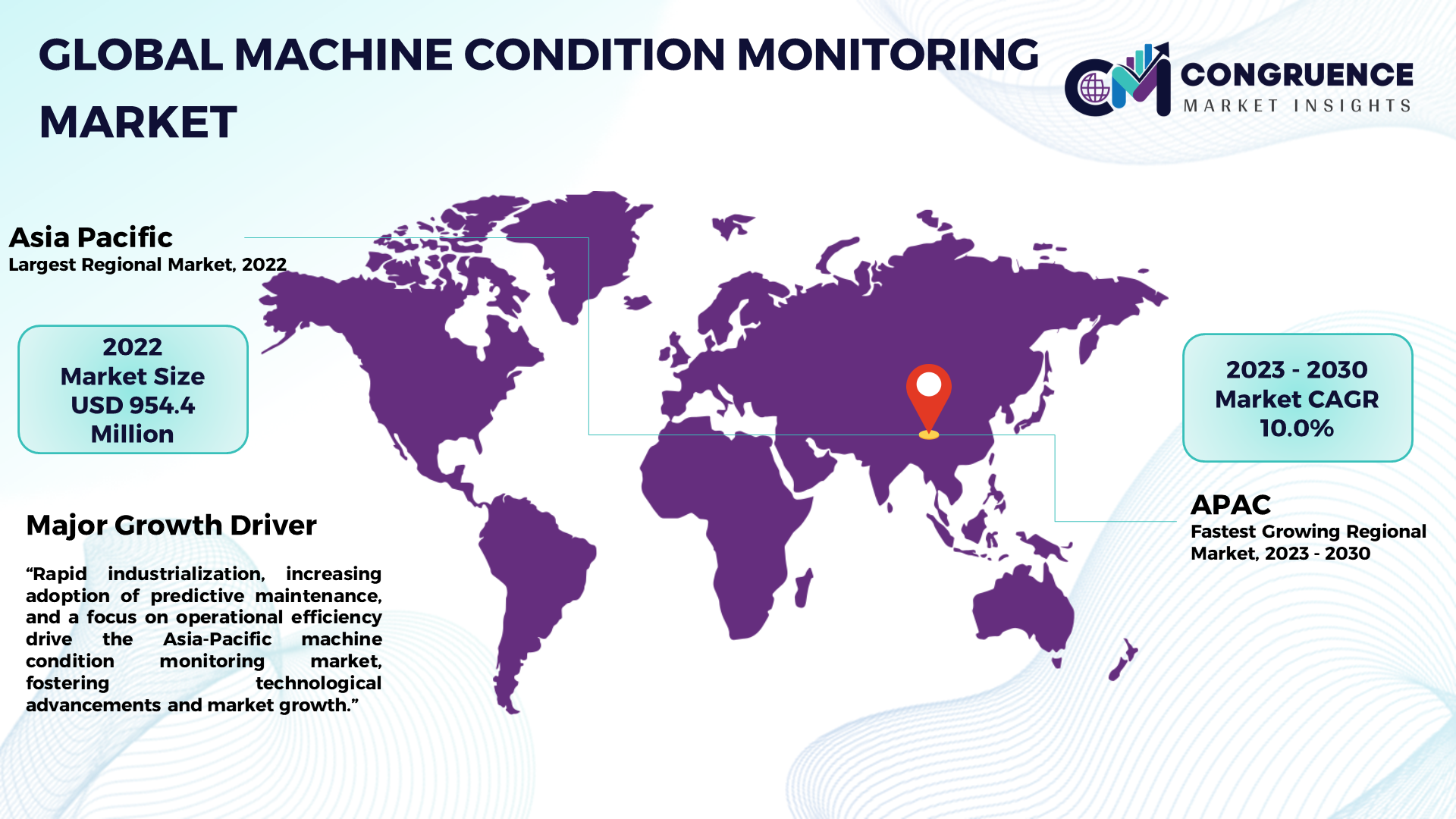Reports
The Global Machine Condition Monitoring Market was valued at USD 2,643.7 Million in 2022 and is anticipated to reach a value of USD 5,363.7 Million by 2030 expanding at a CAGR of 9.3% between 2023 and 2030.
The process of keeping an eye on a machine's condition is known as machine condition monitoring. By monitoring the machine's many parameters, including pressure, temperature, humidity, and others, it essentially aids in the prediction of mechanical wear and failure. Additionally, it offers an early warning system that enables the machines to identify damage at the right time and aids in halting additional consequential harm. The primary driver of market expansion will likely be the growing inclination towards predictive maintenance in conjunction with the trends of smart factories or Industry 4.0. The term "machine condition monitoring" describes the global industry devoted to the creation, production, application, and upkeep of instruments, technologies, and solutions intended to evaluate and track the state of machinery and equipment across a range of sectors and industries. This market includes a broad range of sensors, devices, hardware, software, and services that are used to gather, process, and interpret machine data on a regular or intermittent basis in order to evaluate the machine's performance and operational health.

Machine Condition Monitoring Market Major Driving Forces
Growing Interest in Predictive Maintenance: Reactive maintenance is giving way to predictive maintenance tactics in organizations across all industries. Adoption is strongly encouraged by machine condition monitoring since it allows for the early identification of equipment problems, minimizing unscheduled downtime and maintenance expenses.
Increasing Industrial Machinery Complexity: The complexity and interconnectedness of industrial machines have enhanced the necessity for real-time data processing and continuous monitoring. Monitoring machine condition helps keep this complexity under control and guarantees that vital equipment operates at peak efficiency.
Technological Developments in Sensors: Technological advancements in sensor science have produced more affordable and precise sensors for monitoring a range of characteristics, including vibration, temperature, pressure, and oil quality. These developments have reduced the cost and increased accessibility of machine condition monitoring.
Employment in Power Generation: The power generating industry is one that is growing, and this has led to better growth in machine monitoring within the industry. Power generation depends heavily on machine condition monitoring. Gases and oils are also searching for new innovations that will increase safety while being effective and efficient.
Machine Condition Monitoring Market Key Opportunities
Growing Integration of IOT: Machine condition monitoring is anticipated to be greatly impacted by the Internet of Things (IoT) in the future. The vast collection and analysis of real-time data on an IoT scale will be made possible by the integration of sensors and monitoring systems. Opportunities for more thorough and anticipatory maintenance strategies will arise as a result.
Savings on Energy and Expenses: Machine condition monitoring identifies inefficient machinery and processes, which aids in energy optimization. This appeals to industries that care about the environment since it lowers energy costs and supports sustainability objectives.
Demand for Predictive Maintenance: Machine condition monitoring systems are becoming increasingly in demand as proactive maintenance tactics replace reactive ones. Predictive maintenance is being used by industries more and more to cut expenses and downtime.
Machine Condition Monitoring Market Key Trends
· Industry 4.0 projects are increasingly including machine condition monitoring, which takes advantage of the Internet of Things' (IoT) ability to provide seamless communication.
· Machine condition monitoring is making predictive maintenance more and more popular.
· Machine condition monitoring is increasingly using artificial intelligence, machine learning, and advanced data analytics.
· Machine condition monitoring systems that are cloud-based are becoming more popular since they provide accessibility, scalability, and flexibility.
· In order to facilitate real-time data analysis at the source, edge computing is becoming more and more important in machine condition monitoring.
· User-friendly interface design is becoming more and more popular in machine condition monitoring solutions.
· Applications for machine condition monitoring are expanding beyond the conventional manufacturing industries.
Region-wise Market Insights
Asia Pacific accounted for the largest market share at 36.1% in 2022 moreover, Asia Pacific is also expected to register the fastest growth, expanding at a CAGR of 10.0% between 2023 and 2030.

Asia Pacific dominated the market in 2022 with more than 36.1% of global sales. In contrast to the optimistic demand from the power generation, aerospace, oil and gas, marine, and food and beverage industries, the United States and Canada are expected to offer strong growth prospects. When it comes to oil condition monitoring in lubricants used in oil and gas platform machinery, vibration monitoring has become increasingly popular. As offshore oil exploration increases across North America, organizations with a forward-thinking approach may be able to solidify their place in the local market. Over the course of the forecast period, Asia Pacific is expected to post the fastest CAGR. China is expected to lead the region's market due to its vast manufacturing base and government activities encouraging Industry 4.0 technology, followed by India and Japan. The use of Industry 4.0 technologies such as artificial intelligence (AI), machine learning, and big data analytics to automate and optimize manufacturing processes and improve the effectiveness of machine condition monitoring is one of the main factors driving this rise. Demand is also being driven up by firms' increasing understanding of the benefits of machine condition monitoring, which include enhanced productivity and equipment reliability. Furthermore, Europe can turn into a lucrative region for automakers due to the growing use of artificial intelligence and machine learning. The need for online condition monitoring may be fueled by industry dynamics, indicating potential market expansion.
Market Competition Landscape
The intense competition among several players is a defining feature of the worldwide machine condition monitoring industry. Important participants in the market for machine condition monitoring employ tactics meant to provide them a competitive advantage. Prioritizing both organic and inorganic strategies, such as product offers, technological advancements, M&As, regional expansion, and inventions, is important for both existing and new businesses. Trends in predictive maintenance and the expansion of IoT will serve as catalysts for their expansion into uncharted territories. Prominent players in the market include:
· Emerson Electric Co.
· General Electric
· Honeywell International Inc.
· National Instruments Corp.
· AB SRF
· ALS
· Wilcoxon Sensing Technologies,
· Rockwell Automation, Inc.
· PARKER HANNIFIN CORP
· Schaeffler AG
· SYMPHONY AZIMAAI
· Brüel & Kjær
· Fluke Corporation
· Meggitt PLC
· PCB Piezotronics, Inc.
· FLIR Systems, Inc.
· SPM Instrument AB
· Analog Devices, Inc.
· Machine Saver
· 3d SignalsLogiLube, LLC
· Petasense Inc.
· Senseye Ltd.
|
Report Attribute/Metric |
Details |
|
Market Revenue in 2022 |
USD 2,643.7 Million |
|
Market Revenue in 2030 |
USD 5,363.7 Million |
|
CAGR (2023 – 2030) |
9.3% |
|
Base Year |
2022 |
|
Forecast Period |
2023 – 2030 |
|
Historical Data |
2018 to 2022 |
|
Forecast Unit |
Value (US$ Mn) |
|
Key Report Deliverable |
Revenue Forecast, Growth Trends, Market Dynamics, Segmental Overview, Regional and Country-wise Analysis, Competition Landscape |
|
Segments Covered |
· By Offering (Hardware and Software) · By Deployment Type (On-premises, Cloud) · By Monitoring Technique (Vibration Monitoring, Thermography, Oil Analysis, Corrosion Monitoring, Ultrasound Emission and Motor Current Analysis) · By Monitoring Process (Online Condition Monitoring and Portable Condition Monitoring) · By End-Use (Oil and Gas, Power Generation, Metals and Mining, Chemicals, Automotive, Aerospace and Defense, Food and Beverages, Marine and Others) |
|
Geographies Covered |
North America: U.S., Canada and Mexico Europe: Germany, France, U.K., Italy, Spain, and Rest of Europe Asia Pacific: China, India, Japan, South Korea, Southeast Asia, and Rest of Asia Pacific South America: Brazil, Argentina, and Rest of Latin America Middle East & Africa: GCC Countries, South Africa, and Rest of Middle East & Africa |
|
Key Players Analyzed |
Emerson Electric Co., General Electric, Honeywell International Inc., National Instruments Corp., AB SRF, ALS, Wilcoxon Sensing Technologies, Rockwell Automation, Inc., PARKER HANNIFIN CORP, Schaeffler AG, SYMPHONY AZIMAAI, Brüel & Kjær, Fluke Corporation, Meggitt PLC, PCB Piezotronics, Inc., FLIR Systems, Inc., SPM Instrument AB, Analog Devices, Inc., Machine Saver, 3d SignalsLogiLube, LLC, Petasense Inc., and Senseye Ltd. |
|
Customization & Pricing |
Available on Request (10% Customization is Free) |
